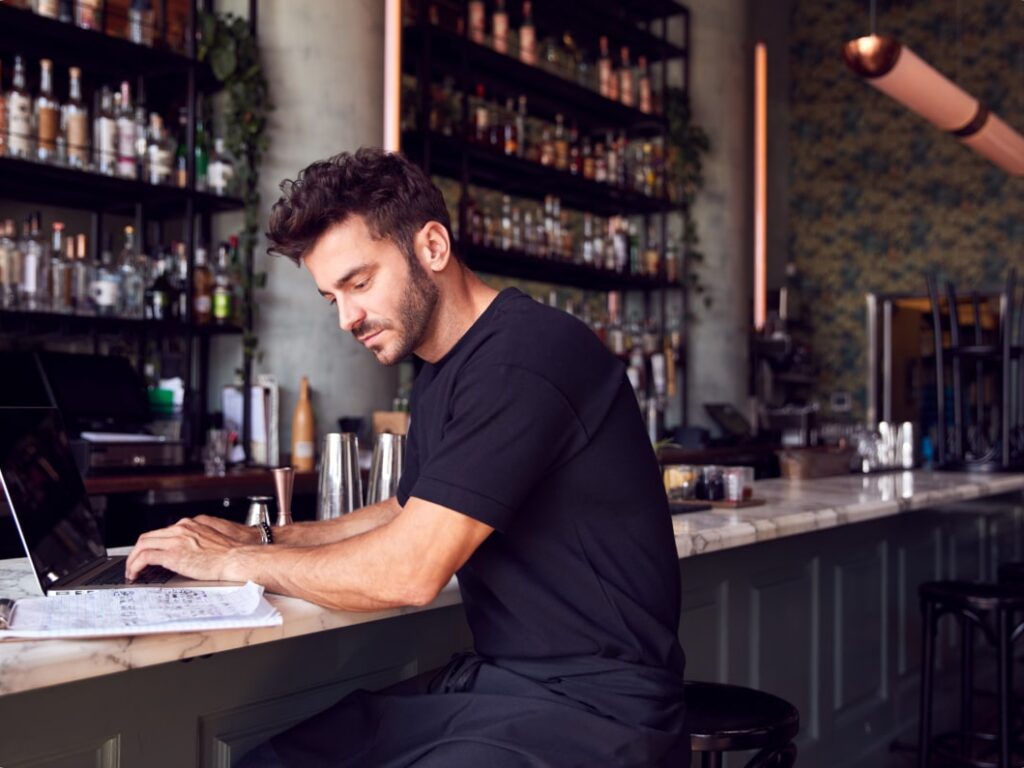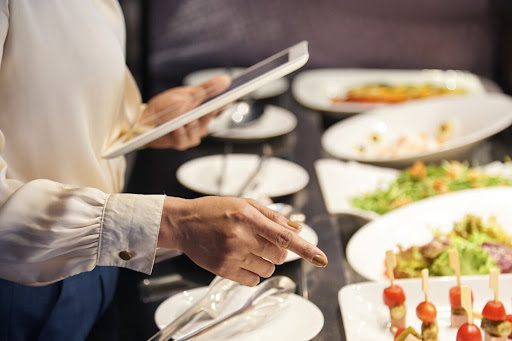What is food cost?
Restaurant food cost is the ratio of the cost of ingredients (i.e. food inventory) and the revenue these food items generate when sold. Most of the time, it is referenced as a percentage. Determining the cost of food provides a clearer picture of how much money is being made or lost.
It has a substantial impact on restaurant finances so restaurant owners should make sure to calculate food cost percentage regularly. This ratio can let them know if their menu pricing strategy is right, if they should negotiate with suppliers, if they should improve inventory management, etc.
How do you calculate food cost in a restaurant?
Determining your food cost is important and calculating how much you are going to sell your food for is a big part of this equation. In order to figure out how to maximize your profits, you need to price your menu right.
To achieve this, it is important that you determine what your ideal food cost percentage is. Once you have this figure, you are going to want to divide the cost it takes to make the menu item by the ideal food cost percentage and then multiply that number by 100.
For example, if it costs you $5 to make a pizza, and your ideal cost percentage is 30%, you should divide 5 by 30 and multiply that number by 100 which rounds up to $16.67. According to this equation, you should sell your pizza for $16.67.
What is food cost percentage?
Food cost percentage is generally used to price dishes in a restaurant. It helps you calculate how much money your restaurant makes on a given menu item. Food cost percentage is a ratio that tells you how much your ingredients cost compared to the revenue that they generate when they are sold.
How to calculate food cost percentage
Calculating your food cost percentage is slightly more complicated than calculating your food cost for individual menu items. In order to calculate your food cost percentage, you need to first gather the information below and numbers for a given period of time (weekly, monthly, etc.):
- Beginning inventory
- Purchases
- Ending inventory
- Total food sales
Once you have all of this information, you need to add the beginning inventory and purchases and then take away the ending inventory from that number. You then divide all of that by the total sales for the period.
To calculate the food cost percentage, you will need to use the following formula:
Food cost percentage = (Beginning Inventory – Purchases) – Ending InventoryTotal Food Sales
Here is an example with some real numbers:
- Beginning inventory – $10,000
- Purchases – $3,000
- Ending inventory – $10,000
- Total sales – $10,000
Food cost percentage = ($10,000 + $3,000) – $10,000$10,000= 30%
What is the ideal food cost percentage?
As a good rule of thumb, your ideal food cost percentage sits somewhere below 35%. However, everyone’s ideal food cost percentage will differ depending on how much they are spending on food and other such expenses.
Tips to optimize food cost percentage
At the end of the day, the main objective of any restaurant is to optimize gross profit margins and one of the best ways to do this is to optimize food cost percentage. Unfortunately, many restaurants overlook just how important food cost percentage is. In order to help you avoid falling into that trap, we share some expert tips to help you reduce your food costs.
1. Review your menu pricing strategy
Menu pricing is key to ensuring your restaurant generates good revenues. It can be tempting to set menu prices really high as you think you’ll make more money, but in reality, if your food is unreasonably priced, not many customers are going to be willing to pay for it. Similarly, if your menu items are underpriced, you will get a lot of customers but you may not generate sufficient revenues to cover your expenses.
To make sure your menu is priced correctly, determine your ideal food cost percentage and use the above formula to figure out how much you should charge for each menu item to maximize profits.
2. Shop around for suppliers
As much as it is important to get your pricing right, it is also important to reduce your costs whenever you can as this will also affect your food cost percentage. Although you might have used one supplier for a long time and are a loyal customer, the truth of the matter is that you are probably not getting the best rates for your ingredients.
It is important to regularly shop around for suppliers and not become complacent. Prices change all the time so you need to move with this and assess the trends. Also, don’t be scared to use multiple suppliers. For example, if you’ve found one supplier that has cheap fresh produce and another who has cheap pantry items, why not work with both?
3. Inventory management
Food waste is a big contributor to your food cost percentage as your beginning and ending inventory is part of the equation. If you are overbuying food, your food cost percentage is going to be out of sync as you are spending more than you need to on ingredients and they are simply going to waste.
In order to avoid this, you should optimize inventory management. You can assign one person from your team who does weekly inventory checks, identifies trends in food wastage and finds solutions to reduce waste. This can also be done through a POS system that tracks the food that is sold against your beginning inventory to identify what ingredients are used the most and which are left on the shelf for long periods of time.
How to set menu prices for your restaurant
Just as with food cost percentage and ideal food cost percentage, there is a formula to help you set all your menu prices. All you need to do is divide the cost per serving by your ideal food cost percentage. Doing this will help you to increase your bottom line and ensure you are making a reasonable amount of gross profit on each menu item.
3 ways to reduce losses and costs in your restaurant
Reducing losses such as food wastage and costs in your restaurant is a guaranteed way to ensure you maximize your gross profit margin. The restaurant industry is so competitive that you need to save as much money in as many places as possible without compromising on the quality of your food or customer experience. In order to help you do this, we have collated some of our top tips to show you how to minimize losses and costs and maximize profit.
1. Invest in a POS system
At the end of the day, technology is your best friend. Software such as a POS system can do instantaneously what it would take an employee around an hour to do. For example, some of the most advanced POS systems will not only record orders but will also track them against your inventory. This therefore allows you to see in real time what stock you are low on and what stock you have far too much of.
From here, many POS systems will allow you to directly order from your supplier from inside the software, hence ensuring you never run out of menu items and are keeping customers happy. On the other hand, it also highlights what you are over buys and allows you to adjust this and reduce your waste.
2. Get a custom online ordering system
A custom online ordering system is the perfect way to reduce losses in your restaurant, especially during these unprecedented times. Considering the drop in foot traffic, it’s important that you take advantage of an online sales channel. After all, the more revenue streams you have, the better your top line. A better top line can help mitigate the impact of increased operational costs.
Customer experience is what drives the success of restaurant businesses. Whether a customer is dining out or ordering online, their experience will dictate whether they order from your restaurant again or not. A well-designed restaurant ordering system leads to overall business growth as it makes it possible to personalize the customer journey thanks to artificial intelligence.
As your restaurant business grows, the complexity of your operations grows. Customers have more points of contact to interact with your restaurant (online and offline). An efficient restaurant ordering system must ensure that the restaurant operating team has visibility into all order entry channels. The fastest growing restaurants opt for an omnichannel approach as it keeps customers at the center of the entire experience and increases customer loyalty.
You can offer a highly personalized ordering and payment experience to your customers with UEAT’s online ordering system:
- Intuitive interface
- Increased conversion rates
- Custom mobile app and ordering system tailored to your brand
- Access to insights and valuable customer data
- Artificial intelligence upselling module
- Smart marketing tools
- Delivery ecosystem
3. Improve your marketing strategy
Reducing costs and losses is not just about managing your finances correctly, it also has a lot to do with demand. It’s important that you have a constant flow of people coming in and out of your business. At the end of the day, if you don’t have customers, your inventory is going to waste and you’re not generating money.
While most restaurants have loyal customers, it is equally important to ensure you have new people discovering and visiting your restaurant too in order to increase your reach and hopefully gain some more loyal customers. In order to do this, you need to have an airtight and well thought out marketing strategy.
UEAT’s online ordering system comes with smart marketing tools to help you personalize your marketing campaigns. It also lets you access reports that track online ordering trends to make sure you cater to what people are interested in.
Overview
Technology is your best ally to reduce losses and costs. In the modern digital age, you cannot get away with running a business without having an online presence. The pandemic has accentuated customer concerns about safety and security which has accelerated the growth of online orders. Restaurants that don’t digitize their business will fail to respond to their customers’ needs and won’t be able to stand out in a highly saturated market.

Subscribe to our newsletter for the latest insights in restaurant management
By clicking the button above, you agree that UEAT will use your information to contact you about relevant products, content and events. You can unsubscribe from these communications at any time. For more information, see our Privacy Policy.
